#Data Recovery Solutions
Explore tagged Tumblr posts
Text
Cost-Benefit Analysis of Implementing DRaaS for Your Business

The consequences of data breaches have never been unambiguous, and businesses should pay attention to the robustness and accessibility of their data. Growing dependence on digital frameworks in organization operations has made Disaster Recovery solutions more critical than ever. Earlier, companies have benefitted from classic disaster recovery solutions, but with the emergence of Disaster Recovery as a Service or DRaaS, businesses are in a much better position. This blog will go through a detailed cost comparison analysis of DRaaS against conventional disaster recovery techniques and how DRaaS services can be of immense value to organizations, regardless of their size.
Understanding DRaaS and Traditional Disaster Recovery
Traditional Disaster Recovery:
Traditional disaster recovery typically involves maintaining a secondary physical data center that mirrors the primary one. Businesses can switch to this secondary site in a disaster to continue operations. This method often includes cold backups, hot and warm standby systems, and manual failover processes.
Disaster Recovery as a Service (DRaaS):
DRaaS is a cloud-based solution that replicates and hosts your critical data and IT infrastructure on the cloud. It allows companies to protect vital systems and information by copying it offsite. In the event of disasters such as fires, floods, or power outages disabling the primary systems, DRaaS provides swift switching to the duplicated surroundings stationed in the cloud. This enables businesses to restart dealing with clients again right away. DRaaS presents diverse tiers including blazing speed, still warm, and amiable cold recovery alternatives that satisfy assorted recovery time and point objectives for information restoration. The blazing speed choice synchronizes information continuously for the speediest recovery whereas the laidback cold choice backups information less often with a slower recovery.

1. Upfront and Operational Costs
The primary financial burden of traditional disaster recovery lies in the significant upfront costs. Businesses must invest in a secondary data center’s physical infrastructure, including servers, storage, and networking equipment. The operational costs include maintenance, power, cooling, and staffing for the secondary site. Over time, these expenses can escalate, making traditional disaster recovery expensive.
DRaaS, on the other hand, eliminates the need for a secondary physical site. Since DRaaS operates in the cloud, businesses can save costly upfront investments in hardware and infrastructure that traditional disaster recovery requires. Rather than paying large sums upfront for hardware, DRaaS uses a subscription model where businesses only cover resources utilized. Such flexibility considerably trims initial capital expenses while ongoing operational costs remain predictable. Moreover, DRaaS furnishes the adjustability to modulate cloud provisions by fluctuating business needs, enhancing value. The pay-as-you-employ design streamlines output to optimize resource use hand-in-hand with affordability. Altogether, DRaaS carves a smoother trajectory toward resilience for outfits of any size.
2. Scalability and Flexibility
To Scale a traditional disaster recovery infrastructure it can be challenging and costly. Expanding the capacity of a secondary data center requires additional investments in hardware, space, and personnel. Moreover, scaling down in response to changing business needs can result in underutilized assets, leading to wasted resources.
DRaaS solutions offers unparalleled scalability and flexibility so Businesses can quickly scale their disaster recovery resources up or down based on their requirements of the situation. Whether adding more storage, increasing computational power, or extending to additional locations, DRaaS provides the agility to adapt to changing circumstances.
Imagine a mid-sized enterprise experiencing rapid growth and expansion into new markets. Under a traditional disaster recovery model, this business must invest heftily in expanding its secondary data center. However, with a reliable DRaaS service provider, the company can effortlessly scale its disaster recovery resources to accommodate the growth, ensuring that new data and systems are protected without additional physical infrastructure.
3. Recovery Time Objective (RTO) and Recovery Point Objective (RPO)
Traditional disaster recovery methods often involve longer RTOs and RPOs, especially if manual failover processes are in place. The time required to bring the secondary data center online, restore data, and resume operations can vary depending on the complexity of the setup. This delay can result in extended downtime and potential data loss, which can have severe financial and reputational impacts.
DRaaS significantly reduces RTOs and RPOs by leveraging automated failover processes and cloud-based replication. ESDS’s DRaaS solutions offer multiple tiers Hot DR, Warm DR, and Cold DR—each tailored to meet specific RTO and RPO requirements. For instance, Hot DR ensures immediate failover with near-zero data loss, making it ideal for mission-critical applications. Customizing RTO and RPO according to business needs protects that traditional methods may struggle to match.
Consider a financial services company that requires high availability and minimal downtime due to the critical nature of its operations. Traditional disaster recovery methods might not meet the stringent RTO and RPO requirements, potentially leading to financial losses and customer dissatisfaction during a disaster. By implementing a Hot DR solution, the company can achieve immediate failover with zero data loss, ensuring that operations continue seamlessly even in the face of a disaster.
4. Maintenance and Management
Maintaining a traditional disaster recovery setup requires ongoing management, monitoring, and regular testing to ensure readiness. This can be resource-intensive, requiring dedicated personnel and time. Additionally, updates and upgrades to the infrastructure can further complicate the maintenance process.
DRaaS simplifies maintenance and management by shifting the burden to the service provider. That offers DRaaS solutions which include regular testing, monitoring, and updates as part of the service, ensuring that disaster recovery plans are always up-to-date and functional. This allows businesses to focus on their core operations without the distraction of managing complex disaster recovery infrastructure.
Managing a traditional disaster recovery setup could be overwhelming and prone to errors for a small business with a limited IT staff. Businesses must choose a DRaaS service provider that helps businesses offload maintenance and management responsibilities, ensuring that disaster recovery plans are always ready without straining internal resources.
5. Return on Investment (ROI)
The ROI for traditional disaster recovery can be difficult to justify, especially for businesses that do not experience frequent disasters. The high costs of maintaining a secondary data center and the potential for underutilized assets can result in a lower ROI.
DRaaS offers a higher ROI by providing cost-effective disaster recovery solutions that scale with business needs. The pay-as-you-go model ensures that businesses only pay for the resources they use, maximizing cost efficiency. Additionally, the ability to quickly recover from a disaster with minimal downtime and data loss translates to tangible financial benefits, including reduced operational disruptions and preserved revenue streams.
A manufacturing company that implemented DRaaS to protect its critical production data. Over five years, the company experienced several instances where DRaaS was activated due to natural disasters and cyberattacks. Each time, the company was able to resume operations quickly, minimizing losses and maintaining customer trust. The cumulative cost savings and business continuity ensured a high ROI, far outweighing the costs of the DRaaS subscription.
Conclusion
The cost-benefit analysis shows that adopting Disaster Recovery as a Service (DRaaS) offers superior value to traditional disaster recovery methods. From reduced upfront and operational costs to enhanced scalability, flexibility, and faster recovery times, DRaaS empowers businesses to protect their operations without traditional approaches’ financial and logistical burdens. ESDS‘s DRaaS solutions, with their tiered offerings and comprehensive support, provide businesses with the tools they need to ensure business continuity, minimize downtime, and achieve a higher return on investment.
For IT Managers, CIOs, business owners, and IT professionals seeking a reliable and cost-effective disaster recovery solution, ESDS DRaaS is the clear choice to safeguard your business against any disaster scenario.
0 notes
Text
Explore the essential benefits of cloud backup and restore solutions for business continuity. Learn how cloud technology safeguards data and enhances operational resilience.
#cloud backup benefits#data recovery solutions#business cloud restore#advantages of cloud storage#disaster recovery cloud services.
0 notes
Text
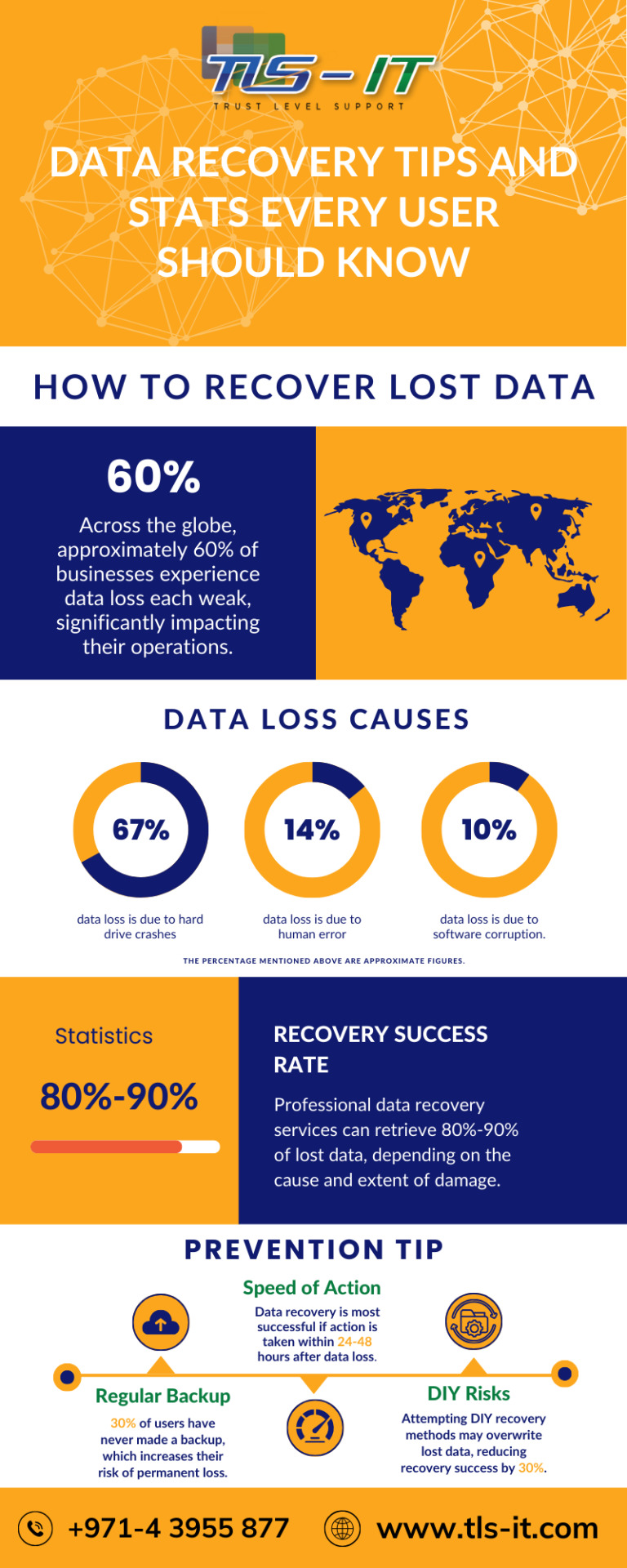
Fast, reliable data recovery solutions to retrieve lost files and protect your business from data loss impacts.
0 notes
Text
didn't save 12 hours worth of writing and editing, having a nervous breakdown and am ready to never write a single word again
#I'm literally the girl crying incoherent in German meme#and if anyone is going to come with well meant recovery file tips I'm going to end them#I've been through every recovery trick google has to offer#the audacity of those pages also to end their list of solutions with a “how to prevent data loss in the future” tips#writing
11 notes
·
View notes
Text
Choosing the Right Managed IT Service Provider for Healthcare

The healthcare industry increasingly depends on technology to improve patient care, streamline operations, and ensure compliance. With the growth in cybersecurity threats, there is an increased need for seamless IT infrastructure and managed IT service providers. Choosing the right managed services provider (MSP) is challenging but essential for optimizing cloud operations. Look for experienced and certified MSP Certifications. Ensure they offer comprehensive monitoring, security, data backup, and disaster recovery services. Additionally, ensure they scale with your business, provide 24/7 support, and follow industry standards for security.
Understanding Managed IT Services in Healthcare
What Are Managed IT Services for Healthcare?
Managed IT services in healthcare involve outsourcing a healthcare facility’s IT infrastructure and operations to a third party at a lower cost than running an internal department. Third-party service providers for medically managed services are also known as managed service providers.
Why Do Healthcare Organizations Need IT Service Management?
Healthcare organizations need IT-managed service providers to establish efficient access to sensitive patient data, improve operational efficiency, enhance patient safety by streamlining processes, reduce costs, and deliver better quality care by aligning IT services with the organization’s healthcare goals.
Key Benefits of Healthcare IT Managed Service Providers
Enhanced Cybersecurity and Compliance
One key benefit of utilizing a healthcare IT-managed service provider is remarkably enhancing cybersecurity and compliance to ensure that sensitive patient data is protected at all costs while adhering to strict industry regulations. It allows healthcare organizations to focus on patient care while minimizing the risk of data breaches.
Improved Efficiency and Reduced Downtime
Healthcare-managed IT service providers offer benefits like improved operational efficiency and significantly reduced downtime. It is easy to achieve by proactive monitoring, rapid issue resolution, on-point technical support, and scalable infrastructure. This helps healthcare organizations deliver excellent patient care while ensuring their IT systems run smoothly and securely without hampering patient care.
Cost Savings and Scalability
Healthcare IT managed services focus on cost savings through outsourcing IT management, making more efficient use of resources and scalability to adapt to changing healthcare needs. Healthcare organizations should be able to scale their IT infrastructure up or down as required.
How to Choose the Best Healthcare IT Managed Service Provider
Experience in Healthcare IT Service Management
While choosing the best healthcare IT-managed service provider for your facility, prioritize their experience in the healthcare industry. Verify that they understand your facility's unique IT needs and compliance regulations like HIPAA and have expertise in managing electronic health records.
Compliance with HIPAA and Other Regulations
Prioritize healthcare IT-managed service providers with a strong track record of security practices, a deep and thorough understanding of healthcare regulations, and proven expertise in data protection.
24/7 Support and Proactive Monitoring
Look for healthcare IT-managed service providers with deep healthcare industry experience, strong compliance records, robust monitoring capabilities, and a proven track record of offering 24/7 support.
Customization and Scalability of IT Solutions
When choosing a healthcare IT-managed service provider, look for their ability to offer customized and scalable IT solutions that align well with your facility’s unique needs. Evaluate their experience in the healthcare industry based on their technical expertise, compliance, and capability to adapt to changing situations.
Common Mistakes to Avoid When Selecting a Healthcare IT Service Provider
When choosing a healthcare IT-managed service provider, common mistakes to avoid include:
Focusing only on the price
Not clearly defining your needs
Ignoring their experience in the healthcare industry
Overlooking security and compliance concerns
Failing to check their reputation
Not understanding their service model
Not checking references and reputation
Not considering future needs
Future Trends in Managed IT Services for Healthcare
The healthcare IT landscape is evolving rapidly, with new technologies shaping the future of managed IT services. Trends include:
AI-driven automation for predictive maintenance and cybersecurity threat detection.
Blockchain technology for secure and transparent patient data management.
Cloud-based healthcare systems for enhanced interoperability and accessibility.
Telehealth advancements powered by 5G and edge computing
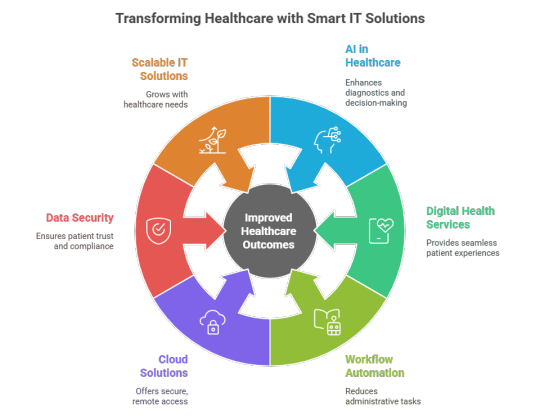
Conclusion: Ensuring the Best IT Support for Healthcare Organizations
Selecting the right healthcare IT-managed service provider is essential for healthcare organizations looking to enhance cybersecurity, compliance, and operational efficiency. The ideal MSP should offer:
Expertise in healthcare IT and experience managing cybersecurity and compliance.
24/7 monitoring and proactive IT support to minimize downtime and security risks.
Customizable and scalable IT solutions aligning with healthcare needs.
By partnering with a reputed and reliable healthcare IT-managed service provider like XLNC Technologies, healthcare organizations can focus on delivering exceptional patient care while maintaining secure and efficient IT systems.
FAQs
What are the key factors to consider when choosing a managed IT service provider for healthcare?
Healthcare organizations should evaluate industry expertise, HIPAA compliance, cybersecurity capabilities, 24/7 support, scalability, and integration with existing systems. A provider with proven experience in healthcare IT, proactive monitoring, and customized solutions ensures operational efficiency, regulatory adherence, and uninterrupted patient care.
How do healthcare IT-managed service providers help with regulatory compliance?
Managed IT service providers to ensure HIPAA and GDPR compliance by implementing secure data encryption, access controls, regular security audits, and automated risk assessments. They help healthcare organizations avoid fines, prevent data breaches, and maintain regulatory compliance through ongoing monitoring, documentation, and proactive security measures.
Why is cybersecurity crucial in managed IT services for healthcare?
Cybersecurity is essential to protect sensitive patient data from ransomware, phishing attacks, and unauthorized access. MSPs provide AI-driven threat detection, zero-trust security models, real-time monitoring, and multi-layered encryption to safeguard electronic health records (EHRs) and ensure uninterrupted healthcare operations.
What are the benefits of outsourcing IT service management in healthcare?
Outsourcing IT services reduces costs, enhances security, minimizes downtime, and improves scalability. Managed IT providers offer 24/7 support, cloud-based solutions, proactive monitoring, and compliance management, allowing healthcare organizations to focus on patient care rather than IT complexities
How can a healthcare IT-managed service provider improve patient care?
MSPs improve patient care by ensuring secure, fast access to medical records, enabling seamless telehealth solutions, reducing system downtime, and enhancing data accuracy. With real-time monitoring and AI-powered automation, providers can deliver efficient, uninterrupted, high-quality healthcare services.
#Managed IT Services for Healthcare#Healthcare IT Solutions#Healthcare Digital Transformation#IT Support for Hospitals#Cloud Solutions in Healthcare#Healthcare Data Security#HIPAA Compliance#Healthcare IT Compliance#Telehealth IT Support#Electronic Health Records#EHR Management#Cybersecurity in Healthcare#Remote Patient Monitoring#IT Infrastructure Management#24/7 IT Support for Healthcare#IT Outsourcing in Healthcare#Disaster Recovery for Hospitals#Cost-effective IT Services#Patient Data Protection#Healthcare Compliance Solutions#Healthcare Cloud Management#Managed Service Providers for Healthcare#Improving Patient Experience with IT#Healthcare IT Consulting
0 notes
Text
Automated Disaster Recovery Solutions by Esconet Technologies
Esconet Technologies, based in New Delhi, offers comprehensive Automated Disaster Recovery (ADR) solutions designed to ensure business continuity and data integrity. Their services encompass Cold DR for cost-effective data backup, Hot DR for real-time data synchronization, and Application-Supported DR to safeguard critical applications like Active Directory and databases. With continuous DR monitoring, management operations, and partnerships with leading OEMs such as Dell Technologies, HPE, VMware, Veeam, and Microsoft, Esconet delivers robust and scalable disaster recovery solutions tailored to diverse organizational needs.
for more details, Visit- Esconet Technologies Automated Disaster Recovery Solutions page
#Automated Disaster Recovery#Business Continuity Solutions#Cold DR Services#Hot DR Solutions#Application-Supported DR#Data Backup and Recovery#DR Monitoring and Management#Esconet Technologies#Disaster Recovery New Delhi#IT Infrastructure Resilience
0 notes
Text
At DVS IT Services, we specialize in Linux Server Management, Cloud Migration, Data Center Migration, Disaster Recovery, and RedHat Satellite Server Solutions. We also offer expert support for AWS Cloud, GCP Cloud, Multi-Cloud Operations, Kubernetes Services, and Linux Patch Management. Our dedicated team of Linux Administrators helps businesses ensure smooth server operations with effective root cause analysis (RCA) and troubleshooting. Learn more about our services at https://dvsitservices.com/.
#At DVS IT Services#Linux Server Management#Cloud Migration#Data Center Migration#Disaster Recovery#RedHat Satellite Server Solutions.#GCP Cloud#Multi-Cloud Operations#Kubernetes Services
0 notes
Text
Why no backup plans even after repeated global IT failures?

With the ultimate backup services offered in the technology industry, organizations fail to implement perfect plans to protect their IT infrastructure. This article discusses the reasons behind worldwide IT failures, how they can be avoided, and how Backup as a Service (BaaS) can be the ultimate solution to avoid such interruptions. Most critical services lacked manual or backup systems, resulting in snaking queues at airports and hospitals grappling with downtime. Organizations must emphasize redundant IT systems and offline operating plans to provide continuity during failure.
Causes of IT failures
Single Point of Failure (SPOF)
Imagine one loose brick collapsing the entire wall, that’s what happens when businesses are overly reliant on one vendor to provide mission-critical services. The failure at CrowdStrike-Microsoft proved the point in one patch effectively stopping global operations dead in their tracks. Redundant systems and vendor diversity mean companies avoid becoming one slip away from disaster.
Absence of contingency plans
Most organizations work on the perilous belief that “it won’t happen to us.” When systems fail, they rush into emergency measures at the last minute, further complicating the situation. With no well-planned fallback procedures, offline operational plans, and automated recovery, companies stand to face extended outages, revenue loss, and damage to reputation.
Cybersecurity breaches
A single ransomware attack can hold an entire organization hostage, and DDoS attacks can bring even the most powerful systems to their knees. Without real-time backups, security-first architecture, and proactive monitoring, companies are sitting ducks for emerging cyber threats that take advantage of IT vulnerabilities.
Software and hardware conflicts
One untested update. One incompatible patch. That’s enough to turn devices into expensive paperweights. IT environments are complex, and software update vs. hardware compatibility can result in system-wide failures. Thorough pre-deployment testing is necessary but frequently ignored.
Regulatory gaps
Would you fly an airplane without backup safety measures? Plenty of companies do the same with their IT systems. When there isn’t regulation requiring redundancy, companies skip cost-cutting shortcuts and put themselves at risk of system failures that could have been prevented. Looking after IT resilience regulations is necessary and can never be considered optional.
The IT updates you can’t control
Unlike other traditional software patches reviewed internally, malware signature updates bypass IT departments directly to endpoint devices—laptops, phones, and webcams. This stealthy and silent risk evades routine security checks, exposing enterprises to operational shutdowns at a moment’s notice.
Lack of vendor-side testing
Companies were left helpless when the buggy update struck. Why? Because they never got a chance to check for disruptions pre-deployment. That is why strong vendor-side validation, staged rollouts, and rollback controls need to be the norm for industry practice. Anything less is an inviting disaster.
Consequences of not having Backup Plans
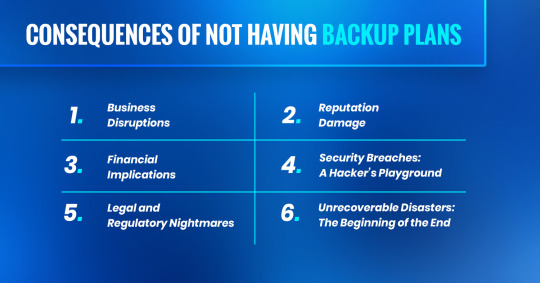
Not having a Business Continuity Plan (BCP) and Disaster Recovery (DR) Plan in place isn’t a minor mistake; it’s a time bomb waiting to sabotage an organization.
Without such precautions, businesses are vulnerable to prolonged downtime, financial instability, security intrusions, legal complications, and irreversible reputation damage.
1. Business disruptions
Every moment of downtime is equivalent to lost business, unhappy customers, and a competitive disadvantage. Without an established backup policy, businesses are vulnerable to:
Prolonged outages that bring business to a standstill.
Missing Recovery Time Targets (RTOs), slowing the restoration process to service.
Dependence on third-party vendors, which ensures slow, unsatisfactory recoveries.
A vacuum for productivity, leaving employees idle while business opportunities vanish.
2. Reputation damage with loss of trust
Trust lost is business lost. Brand reputation takes years to build, but only one incident would ruin it irrevocably. Without an effective backup and recovery mechanism, businesses stand to risk:
Customer discontent and dwindling loyalty.
Negative media coverage, damaging brand reputation.
Investor, stakeholder, and business partner loss of trust.
Customer reluctance to register for new deals, expecting future unreliability.

3. Legal and regulatory nightmares
Data loss or extended downtime is not only a bad business proposition—it’s illegal. Companies with no compliance-oriented backup strategy face:
Tough regulatory penalties and fines for not protecting key data.
Lawsuits from clients for service loss.
Additional scrutiny by regulatory agencies and auditors.
Expensive lawsuits and settlements that waste financial resources.

4. Security breaches become playground for Hackers
Without strong backup plans, businesses become easy targets for cybercriminals. The consequences?
More exposure to ransomware attacks, with no recovery plan.
Sensitive data leaks, causing compliance breaches.
Long-standing security incidents, owing to the absence of quick mitigation actions.
Operational paralysis, rendering incident response disorganized and inefficient.

5. Unrecoverable Disasters: The Beginning of the End
Without a systematic disaster recovery plan, one outage can be the end of business as you know it. Companies without a BCP get into these troubles:
Disorganized, chaotic recovery efforts that waste valuable time.
Slow response to incidents, extending downtime and the resulting damage.
Confusions in leadership, without defined roles or crisis management structure.
Irreversible data loss, operational failures, and possible business shutdown.

6. Financial implications
The monetary impacts of IT failures don’t end with downtime. Organizations need to prepare for:
Insurance disputes and legal claims as companies claim compensation for the disruption of services.
Customer refund claims under SLAs, resulting in unexpected payouts.
The cost of operations increases because of reactive crisis management instead of proactively taking action.
Direct loss of revenue due to extended system downtime.
Skyrocketing emergency recovery expenses that could have been avoided.
A weakened market position provides competitors more advantage.
It leads to irregular cash flows, investor panic, and increased borrowing costs.

Global IT outages due to no back up services
CrowdStrike-Microsoft Outage (2024): A faulty software update initiated global disruptions in the aviation, banking, and healthcare industries.
London NHS Ransomware Attack: A cyberattack froze healthcare services, resulting in the cancellation of surgeries and critical treatment delays.
Facebook Outage (2021): A misconfigured DNS routing issue resulted in a six-hour global blackout that affected billions of users.
Y2K Bug (2000) & 2038 Problem: Computing flaws related to time caused and continue to cause serious threats to worldwide IT systems.
McAfee IT Failure (2010): A faulty update paralyzed tens of thousands of PCs globally, shutting down 1,100 checkout points at Coles (Australia), halting Intel’s operations, and impacting Kentucky State Police (US) and Rhode Island hospitals.
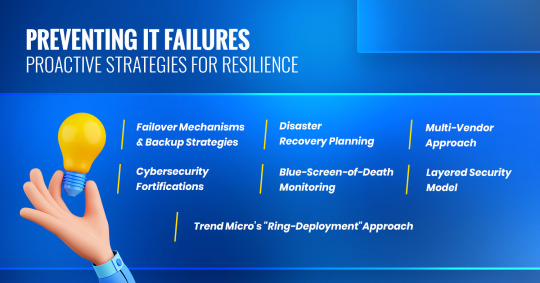
Failover mechanisms & backup strategies: Redundant systems and frequent automated backups enable fast recovery and minimize downtime.
Multi-vendor strategy: Diversification of IT solutions prevents dependency on a single vendor and minimizes Single Point of Failure (SPOF) risks.
Cybersecurity defenses: Strengthening threat detection and countermeasures to respond to constantly evolving cyber-attacks.
Disaster recovery planning: Periodic testing of backup and recovery procedures to guarantee readiness against unexpected crashes.
Trend micro’s “Ring-Deployment” strategy: Rollout of updates in controlled batches prior to global deployment prevents system disruption.
Blue-screen-of-death monitoring: Certain cybersecurity firms immediately monitor and reverse faulty updates, limiting business disruption.
Layered security model: A single cybersecurity solution is not perfect. A hybrid security model guarantees that even when one system fails, another protects operations because fail-proof companies don’t use a single lock.
How Backup as a Service helps in IT failures
Backup as a Service (BaaS) is a cloud-based backup solution that provides business continuity during an outage. The most important advantages are:
Automated & scheduled backups: Assures that critical data is preserved and recoverable at any point in time.
Scalability & flexibility: Organizations are able to scale their backup requirements without major infrastructure investment.
Data security & compliance: Safeguards against cyber threats and meets regulatory standards.
Instant disaster recovery: Allows instant recovery of data and applications in the event of failures.
Backup as a Service can be the best solution
BaaS minimizes downtime, ensures easy data restoration, and provides businesses with an insurance cover against IT breakdowns. With increased dependence on digital services, an effective backup strategy is paramount for businesses to ensure business continuity.
How ESDS Backup as a Service protect businesses from IT outages?
ESDS Backup as a Service provides:
Zero data loss via real-time backup and recovery solutions.
Multi-cloud high availability & redundancy.
Compliant & secure backup with end-to-end encryption.
Quick recovery to get business up and running with minimal downtime.
Wrapping up
A well-structured Business Continuity Plan (BCP) and Disaster Recovery (DR) strategy is the key to resilience, allowing businesses to quickly recover and sustain business integrity. In the absence of these measures, organizations risk financial losses, damage to reputation, and even collapse when disruptions hit.
Even with frequent worldwide IT failures, many companies continue to neglect holistic backup plans. The interconnected nature of today’s IT infrastructure makes it possible for a single failure to initiate cascading disruptions across industries. Strong testing, redundancy, and heterogeneous security solutions are the only means to counter such risks. Backup-as-a-Service (BaaS) offerings such as ESDS BaaS enable companies to strengthen IT infrastructure, avoid disastrous failures, and provide smooth continuity. With increasing IT dependencies, investing in strong backup solutions is no longer a choice, it’s a necessity.
0 notes
Text

Lost important files? Don’t panic! Our Data Recovery Service in Barrie is here to help you retrieve lost, deleted, or corrupted data from hard drives, SSDs, USBs, and more.
Trust us to get your files back with precision and care. Contact us today and let us recover what matters most to you!
📞 Contact us now for a free consultation.
📲705 294 4991 🌐Visit our website: https://macbookscreenrepair.ca/
#Data Recovery Barrie#Tech Solutions#Data Recovery#Computer Data Recovery#Hard Drive Recovery#Mobile Data Recovery#SSD Recovery#Barrie#Ontario
0 notes
Text
Affordable & Reliable IT Solutions | Expert Support Guaranteed
0 notes
Text
Fast iPhone Screen Repairs & Secure Data Recovery at Digimob Phone Repair
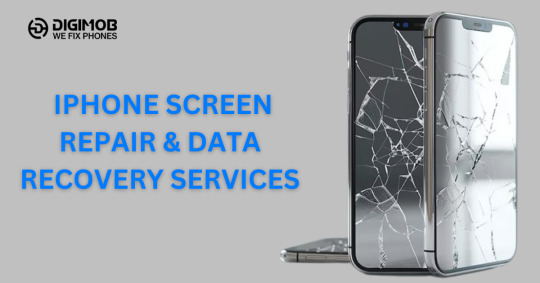
Your iPhone is more than just a phone—it’s a lifeline to your personal and professional world. Whether it’s a cracked screen or a sudden data loss, these issues can be extremely frustrating. Fortunately, professional iPhone phone repairs, including iPhone screen repairs and data recovery services, are here to help restore your device to its original functionality. At Digimob Phone Repair, we specialize in fast, reliable, and affordable iPhone repairs to get you back on track in no time. This blog will guide you through our top services, including screen repairs, battery fixes, and data recovery solutions, ensuring your iPhone is always in optimal condition.
Why Choose Professional iPhone Repair Services?
When your iPhone faces any type of damage, you want to ensure it’s repaired properly. While DIY fixes or third-party repair shops might seem like an affordable solution, they can often lead to more harm than good. Here’s why choosing Digimob Phone Repair for your iPhone phone repairs is the best option:
Expert Technicians: Our technicians are highly trained and experienced in all aspects of iPhone repairs, from screen fixes to data recovery.
Genuine Parts: We use only high-quality, genuine replacement parts to ensure your phone works like new.
Fast Turnaround: We understand that your time is valuable. That’s why we offer quick repair services, often completing repairs on the same day.
Warranty: Our repairs come with a warranty, giving you peace of mind that your device is protected.
iPhone Screen Repair: The Most Common Repair
One of the most common issues iPhone users face is a cracked or shattered screen. Whether it’s the result of a drop or pressure applied to your device, a broken screen can make your phone unusable.
Why iPhone Screen Repair is Essential
Your iPhone’s screen isn’t just for display—it’s the interface you use to navigate your device, make calls, send messages, and browse the web. A cracked or damaged screen can not only affect your ability to use your phone but can also pose a safety risk with sharp edges and potential further damage.
How We Fix Your iPhone Screen
At Digimob Phone Repair, we specialize in providing quick and effective iPhone screen repairs. Here’s how we handle the process:
Evaluation: Our technicians assess the extent of the damage to determine the best course of action.
Screen Replacement: We replace the cracked or broken screen with a brand-new one, ensuring that it works like new.
Quality Check: After replacing the screen, we conduct thorough testing to ensure the touch sensitivity, display clarity, and functionality are perfect.
If you’re facing any issues with your iPhone screen, don’t hesitate to reach out for professional iPhone repairs.
Read more: Fast iPhone Screen Repairs & Secure Data Recovery at Digimob Phone Repair
#iPhone Screen Repair#iPhone Data Recovery#iPhone Repair Services#iPhone Phone Repairs#Professional iPhone Repairs#iPhone Repair Experts#Data Recovery for iPhone#iPhone Screen Fix#iPhone Battery Replacement#iPhone Repair Near Me#iPhone Repair Shop#Fast iPhone Repairs#Affordable iPhone Repair#Screen Repair Services#iPhone Data Protection#Digimob Phone Repair#iPhone Recovery Services#Reliable iPhone Repair#Cracked iPhone Screen Repair#iPhone Repair Solutions
0 notes
Text
Quick iPad Screen Repair Service: Restore Your Device Today
The iPad has become an essential tool for millions of people worldwide. From students and professionals to casual users, the iPad offers convenience, versatility, and performance in one sleek package. However, like any device, accidents happen, and one of the most common issues that iPad owners face is a cracked or broken screen. A damaged screen can render your device unusable, making it essential to seek quick, efficient, and reliable iPad screen repair services. If you find yourself in need of a screen replacement, a quick iPad screen repair service can restore your device today, allowing you to continue using your iPad without delay.
Why Timely iPad Screen Repair Matters
When your iPad screen cracks or shatters, it’s not just an aesthetic issue—it can impact the functionality of the device. A cracked screen can make it difficult to see content clearly, interact with apps, or use the touchscreen effectively. Worse, if the crack worsens over time, it may lead to additional damage to the internal components of the iPad. Addressing the issue quickly by opting for a screen repair can prevent further damage and ensure your iPad remains in working condition.
Moreover, a broken screen can make your iPad vulnerable to dust, dirt, and moisture entering the device. This could lead to more serious problems, such as malfunctions or hardware damage. Repairing the screen as soon as possible will not only restore the aesthetic appeal of your device but also protect it from future complications.
Benefits of Quick iPad Screen Repair Services
Fast Turnaround Time One of the primary benefits of choosing a quick iPad screen repair service is the rapid turnaround. Many repair centers offer same-day or next-day repairs, allowing you to get your device back quickly. Whether your screen is cracked, shattered, or has display issues, professional technicians can replace the screen swiftly, minimizing the amount of time you’re without your iPad. This is particularly important for users who rely on their iPads for work, school, or communication.
High-Quality Replacement Parts When you opt for a professional iPad screen repair service, you can rest assured that the parts used for the repair are of the highest quality. Reputable repair centers use OEM (Original Equipment Manufacturer) or equivalent parts, ensuring that your new screen will function just as well as the original one. Using inferior or third-party parts may result in poor touch sensitivity, color distortion, or other issues, so it’s essential to choose a service that prioritizes quality.
Experienced Technicians Expert technicians with experience in iPad screen repairs can accurately diagnose the problem and provide a fast, effective solution. Whether you own the latest iPad Pro or an older iPad Mini, professionals are trained to handle the specific needs of each model. Their experience ensures that the repair is done correctly, reducing the risk of future issues and restoring your device to its original functionality.
Affordable Pricing Getting a screen repaired is often more affordable than replacing the entire device. Opting for a quick iPad screen repair service allows you to save money while restoring your iPad. Most repair services offer competitive pricing, and you may also have the option of choosing different repair packages based on the extent of the damage. Repairing the screen can be a cost-effective solution compared to buying a brand-new iPad, especially if the device still works well aside from the damaged screen.
Convenient Services In addition to fast repairs, many iPad screen repair services offer convenience through various options such as on-site repairs, mail-in repairs, or home and office pick-up services. These added conveniences ensure that you don’t have to waste time traveling to a repair shop or waiting in long lines. Some services even offer walk-in options, so you can get your iPad repaired on the spot without needing to schedule an appointment.
Warranty and Guarantee Most professional iPad screen repair services offer warranties on the repairs they perform. This means that if any issues arise with the new screen, you can get it fixed free of charge. A warranty provides peace of mind, knowing that your iPad is covered should any problems occur after the repair. It also indicates that the repair center stands behind the quality of their work and the parts they use.
Common iPad Screen Issues That Need Repair
Cracked or Shattered Screens: A cracked or shattered screen is the most obvious sign that your iPad needs repair. Even minor cracks can interfere with the device’s usability, while more extensive damage may cause display issues or make the screen entirely unresponsive.
Unresponsive Touchscreen: If the touchscreen is not responding to taps or gestures, it could be a sign of screen damage or a malfunction within the digitizer. A professional technician can diagnose the problem and replace the screen if necessary.
Display Issues: Sometimes, the screen might not be physically cracked but still exhibit problems like flickering, discoloration, or lines across the display. These issues are often related to internal damage, which can be resolved with a screen replacement.
Dead Pixels or Black Spots: Over time, iPad screens can develop dead pixels or black spots, which can be distracting when using the device. A screen replacement can resolve these visual issues, restoring the display to its original quality.
How to Choose the Right iPad Screen Repair Service
Choosing the right iPad screen repair service is crucial to ensure quality repairs and a quick turnaround. Here are some factors to consider:
Reputation: Look for repair services with positive reviews and a strong reputation for quality work. Recommendations from friends, family, or online reviews can guide your decision.
Expertise: Choose a service that specializes in iPad repairs. Technicians with expertise in handling iPads will have the necessary knowledge and tools to provide the best results.
Turnaround Time: Check if the repair service offers fast turnaround times. Same-day or next-day services are ideal for those who need their iPads quickly.
Warranty: A reputable repair service will offer a warranty on their repairs. This ensures that you can get any issues resolved at no additional cost if something goes wrong.
A cracked or damaged screen doesn’t have to mean the end of your iPad’s functionality. With a quick iPad screen repair service, you can restore your device today and get back to using it as usual. Whether you need a fast turnaround, high-quality replacement parts, or the expertise of experienced technicians, a professional repair service can address your screen issues efficiently and affordably. Don’t let a cracked screen disrupt your daily life—opt for a quick repair and restore your iPad to its full potential.
#Reliable iPad Repair Services – Solutions for all iPad issues.#iPad Screen Replacement – Fix cracked or unresponsive screens.#iPad Battery Replacement#iPad Data Recovery#photos#and documents.#iPad Charging Port Repair#iPad Camera Repair#iPad Water Damage Repair#iPad Speaker & Microphone Repair#iPad Button Repair#volume#or power buttons.#Quick iPad Diagnostics#ipad repair
0 notes
Text
Why Healthcare Providers Need Managed IT Services for Better Patient Care

The healthcare industry is going through a massive digital transformation, with electronic health records, telehealth, cloud-based patient management, and data security becoming the foundation of modern care. A hospital or healthcare center has many things to juggle at once: Accessing a patient’s medical history, checking real-time lab results, and managing endless billing cycles. Managing all this can lead to chaos, operational failure, and bad patient experience. That’s where Managed IT Services comes in.
Studies show that around 84% of hospitals and healthcare centers use cloud services for backup, analytics, and disaster recovery. The integration of IT into healthcare has restructured the industry, from healthcare technology like electronic health records and electronic medical records systems to practice management and telemedicine platforms.
Understanding Managed IT Services in Healthcare
What Are Managed IT Services for Healthcare?
Managed IT services for medical practices and healthcare centers mean outsourcing a facility’s IT functions and operations to a third party at a lower cost than running an internal IT department. The services provided by a third party for managed medical services are known as managed service providers (MSPs).
Common managed IT services for healthcare include:
Cybersecurity and Compliance: Advanced security protocols, including endpoint protection, threat detection, and compliance.
Cloud and Data Management: This service helps secure cloud storage for managing electronic health records, medical imaging, and real-time data access.
24/7 Monitoring and Support: Continuous monitoring of IT infrastructure to detect and resolve issues before they impact healthcare operations. This ensures that healthcare IT systems are always up and running.
Network and Infrastructure Management: Optimizes connectivity for seamless communication
Disaster Recovery and Business Continuity: This includes backup and recovery strategies to safeguard critical patient and operational data in case of system failure.
How Do Healthcare-Managed IT Services Work?
Here’s how IT-managed services work:
Monitoring
Managed IT services to monitor systems, networks, and applications to assess their performance, security, and compliance. For example, they can manage and monitor medical applications and do the necessary upgrades daily.
Maintenance
Managed IT services for healthcare assistance in performing routine maintenance tasks such as software updates, network supervision, and disaster recovery.
Security
Healthcare-managed IT services have 24/7 support for employees, patients, and clinics to improve operational efficiency.
Issue Resolution
They resolve issues in real time through help desks. These help desks can include a general IT help desk, a clinical service help desk, and a patient service help desk. Both employees and patients can use these help desks to resolve their issues in real time.
Challenges in Healthcare IT Management
Cyber Attacks
Cybersecurity is the top challenge for healthcare leaders. Attackers are getting smarter and more strategic; thus, we need stricter norms against cyber attacks.
The healthcare industry is more vulnerable to these types of threats:
Ransomware
Data Breaches
DDoS Attacks
Insider Threats
Healthcare IT Security Risks
One of the biggest risks in healthcare systems is the insecure storage and transmission of sensitive patient data. Weak encryption, poor access control, and bad data handling can allow unauthorized individuals to access patient information, which cybercriminals can use to access valuable data.
The Growing Need for Compliance and Data Protection
Compliance is a big challenge for healthcare providers. Laws like HIPAA require strict measures to protect sensitive patient information, and non-compliance can lead to large fines and legal issues.
Managed IT service for healthcare providers to help healthcare organizations comply by:
Encrypting data and secure access
Conducting regular compliance audits and security assessments
Having data backup and disaster recovery plans in place.
Key Benefits of IT Managed Services in Healthcare
Data Security and HIPAA Compliance
One of the benefits of managed IT services in healthcare is the significant boost in data security and guaranteed HIPAA compliance to protect sensitive patient data/information with continuous monitoring, proactive threat mitigation, and expert guidance in navigating complex healthcare regulations, minimizing data breaches and legal penalties.
Operational Efficiency for Healthcare Providers
IT-managed services in healthcare have proven to improve operational efficiency by streamlining processes, minimizing downtime, and securing sensitive patient data/information to comply with regulations. This will allow healthcare providers to focus on patient care rather than managing IT infrastructure and having access to expert technical support to address issues promptly.
24/7 IT Support and Zero Downtime
IT-managed services in healthcare can provide 24/7 IT support and zero downtime through proactive monitoring and rapid problem-solving. This approach offers remote monitoring and management, disaster recovery solutions, and rapid troubleshooting. This also gives access to on-demand expertise for temporary projects or scenarios where skill sets are not internally employable.
Cost Savings with Healthcare IT Managed Services
Managed IT services can reduce costs by eliminating hardware acquisition and labor costs.
How Managed IT Services Improve Patient Care
Faster Access to Patient Records with Cloud Solutions
Managed IT services can improve patient care by giving faster access to patient records through cloud solutions so healthcare providers can make informed decisions quickly, which will lead to better diagnosis, treatment plans, and overall patient experience while maintaining data security and accessibility anywhere.
Better Telehealth and Remote Patient Monitoring
Managed IT services provide better telehealth and remote patient monitoring. These services allow healthcare providers to deliver continuous patient care through digital platforms. Early interventions, better chronic condition management, and patient engagement simplifications reduce costs.
No Downtime for Uninterrupted Patient Care
Managed IT services mean minimal downtime, and healthcare professionals can focus solely on delivering excellent medical care to patients without technology interruptions.
Choosing the Right Managed IT Services Provider for Healthcare
Key Factors to Consider in Healthcare IT Managed Services
When looking for a managed IT service provider:
Proven experience in the healthcare industry
Proven expertise and compliance with HIPAA and HITRUST
Strong security measures for patient data
Scalability to meet changing needs
Service level agreements (SLAs)
How to Evaluate Managed IT Services for Healthcare Providers
When evaluating managed IT service providers for healthcare:
Do they understand healthcare regulations like HIPAA?
Expertise in relevant technology like EHR
Scalability
Strong cybersecurity practices
Proven track record in healthcare
Clear communication on service-level support
Request case studies and client testimonials
Future of Managed IT Services in Healthcare
As technology advances, managed IT services will use:
AI-driven automation for predictive maintenance
Blockchain for patient data management
Interoperability between healthcare systems
Advanced cybersecurity frameworks for protection against cyber attacks
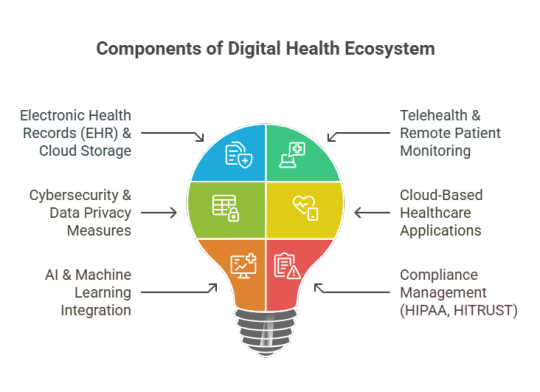
Conclusion: Why Healthcare Providers Must Invest in Managed IT Services
Healthcare providers must invest in IT-managed services to focus on patient care. By outsourcing complex IT infrastructure management, providers can have a robust cybersecurity framework to protect patient data, perform proactive system monitoring for operational efficiency, deliver high-quality care, and comply with industry regulations.
By partnering with a managed IT service provider, healthcare organizations can focus on what matters most—patient care.
With over 20 years of IT consulting and managed services experience, XLNC Technologies helps healthcare providers navigate a digital transformation without compromising security, efficiency, or compliance.
By choosing XLNC Technologies, healthcare organizations have a trusted partner to deliver future-ready IT solutions for seamless, secure, and patient-centric healthcare.
FAQs
What are managed IT services in healthcare, and how do they work?
Managed IT services in healthcare mean outsourcing IT management to specialist providers who ensure security, compliance, and efficiency. They offer 24/7 monitoring, cybersecurity, cloud solutions, and data backup so you can focus on patient care.
How do managed IT services help healthcare providers improve patient care?
They help with patient care by giving fast access to medical records, secure telehealth solutions, and minimal downtime. AI-driven monitoring and cloud-based data storage mean AI-driven seamless care, better diagnoses, and better patient outcomes through secure and efficient technology.
What are the benefits of IT-managed services in healthcare security?
Managed IT services deliver security with AI-driven threat detection, data encryption, zero-trust architecture, and real-time monitoring. They protect electronic health records (EHRs) from cyber threats, ransomware, and data breaches, so you’re HIPAA compliant, and patient data is private.
How can managed IT services help healthcare organizations stay compliant with regulations?
They help with HIPAA and regulatory compliance by implementing strong security protocols, encrypted data storage, and access control. Regular audits, automated risk assessments, and secure backups reduce legal risk and protect patient data from breaches and unauthorized access.
How do healthcare providers choose the right managed IT services provider?
They should evaluate IT vendors based on their industry expertise, 24/7 support, cybersecurity capabilities, compliance readiness, and scalability. Check past performances, case studies, and security frameworks. A provider with proactive monitoring and custom solutions will maintain efficiency, compliance, and better patient care.
#Managed IT Services for Healthcare#Healthcare IT Solutions#Healthcare Digital Transformation#IT Support for Hospitals#Cloud Solutions in Healthcare#Healthcare Data Security#HIPAA Compliance#Healthcare IT Compliance#Telehealth IT Support#Electronic Health Records#EHR Management#Cybersecurity in Healthcare#Remote Patient Monitoring#IT Infrastructure Management#24/7 IT Support for Healthcare#IT Outsourcing in Healthcare#Disaster Recovery for Hospitals#Cost-effective IT Services#Patient Data Protection#Healthcare Compliance Solutions#Healthcare Cloud Management#Managed Service Providers for Healthcare
0 notes
Text
https://www.bloglovin.com/@vastedge/hybrid-cloud-backup-strategy-specifics-benefits
Learn how to create a resilient hybrid cloud backup strategy that combines the best of both private and public clouds. Explore key considerations such as data security, cost management, and disaster recovery to ensure your data is protected and accessible at all times.
#hybrid cloud#cloud backup strategy#data backup#cloud security#disaster recovery#hybrid cloud benefits#cloud storage solutions.
0 notes
Text
Dominating the Market with Cloud Power

Explore how leveraging cloud technology can help businesses dominate the market. Learn how cloud power boosts scalability, reduces costs, enhances innovation, and provides a competitive edge in today's digital landscape. Visit now to read more: Dominating the Market with Cloud Power
#ai-driven cloud platforms#azure cloud platform#business agility with cloud#business innovation with cloud#capital one cloud transformation#cloud adoption in media and entertainment#cloud computing and iot#cloud computing for business growth#cloud computing for financial institutions#cloud computing for start-ups#cloud computing for travel industry#cloud computing in healthcare#cloud computing landscape#Cloud Computing solutions#cloud for operational excellence#cloud infrastructure as a service (iaas)#cloud migration benefits#cloud scalability for enterprises#cloud security and disaster recovery#cloud solutions for competitive advantage#cloud solutions for modern businesses#Cloud storage solutions#cloud technology trends#cloud transformation#cloud-based content management#cloud-based machine learning#cost-efficient cloud services#customer experience enhancement with cloud#data analytics with cloud#digital transformation with cloud
1 note
·
View note
Text
NAKIVO Backup Solutions: Protecting Your Data with Radiant Info Solutions
Discover how NAKIVO Backup Solutions and Radiant Info Solutions ensure comprehensive data protection and recovery for businesses in India.
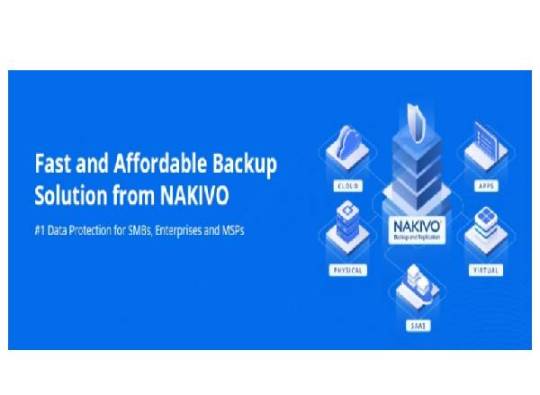
0 notes